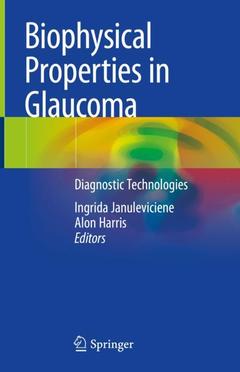Biophysical Properties in Glaucoma, 1st ed. 2019 Diagnostic Technologies
Coordonnateurs : Januleviciene Ingrida, Harris Alon

This book provides an overview on new insights in glaucoma, the latest technological developments, scientific achievements, and novel research leading to new paradigms in glaucoma diagnosis. Readers will discover a broad picture starting from theoretical perspectives in diagnostic criteria followed by practical examination and clinical interpretations while highlighting potential pitfalls and limitations in analysis. Non-invasive, modern technologies allowing visualization and quantification of various parts of the human eye are fast evolving and improving interpretation of modern diagnostic possibilities are essential to fill the gap between sophisticated equipment, complex clinical data, and the need for precision-medicine based interpretation. Issues such as the importance of intraocular, intracranial, and ocular perfusion pressures (IOP, ICP, OPP) in the pathogenesis of glaucoma; and imaging modalities for examination of the optic nerve head, retinal fiber layer, and visual field assessment in glaucoma are explored in these chapters.
The problem-based learning approach presented herein offers a succinct go-to-guide to read and discover answers.?
Introduction.- 1. Importance of intraocular, intracranial and ocular prefusion pressures ( IOP, ICP, OPP) in the pathogenesis of glaucoma.- 1.1 Intraocular pressure as a risk factor.- 1.2 Intracranial pressure as a risk factor.- 1.3 Ocular perfusion pressure as a risk factor.- 1.4 Translaminar pressure difference.- 1.5 Translaminar pressure gradient.- 1.6 Lamina cribrosa (galima ir prie TPG rasyt).- 1.7 Interactions between IOP, ICP, OPP.- 2. Current visualization of anterior chamber angle.- 2.1.Possibilities in anterior segment imaging for glaucoma (UBM, AS-OCT, gonioscopy: advantages and disadvantages).- 2.2. Clinical applications in medical practice: Visualisation of anterior chamber angle, Visualisation of Schlemm`s canal, Visualisation of filtering blebs.- 3. Optic nerve and retina visualization in glaucoma.- 3.1. Imaging techniques of the optic nerve head and retinal fiber layer.- 3.2 Changes of retinal nerve fiber layer.- 3.3 Optic nerve head visualization.- 3.4. OCT - angiography appliance in glaucoma.- 4. Visual field assessment in glaucoma.- 4.1 Visual field examination.- 4.2. Principles of visual field testing.- 4.3. Visual field loss in glaucoma.- 4.4. Static automated perimetry.- 4.5. Visual field test interpretation.- 4.6. Visual function specific perimetry tests (FDT, SWAP).- 5. Structure and function congruency in glaucoma.- 5.1. Structural loss.- 5.2. Functional loss.- 5.3. Correlations between structure and function in glaucomatous damage.- 6. Ocular surface and glaucoma.- 6.1. Ocular surface anatomy and physiology.- 6.2. Ocular surface evaluation prior to glaucoma medical treatment.- 6.3. Glaucoma medication effect to ocular surface: toxicity, allergy, inflammation.- 6.4. Additional substances to glaucoma medication: preservative free treatment.- 6.5. Glaucoma: comorbidity with dry eye disease.
Professor Ingrida Januleviciene (IJ) is professor in the Eye Clinic of Lithuanian University of Health Sciences, Head of Outpatient department and consulting ophthalmologist. IJ is Dean of International Relations and Study center; President of Lithuanian Glaucoma Society; Executive Board member of European Glaucoma Society; Member of World Health Organization Ophthalmology Topic Advisory Group contributing to the revision of the International Classification of Diseases 11th edition; Board member of European Ophthalmological Society; Member of Educational Committe of World Glaucoma Association. Scientific expertise is focused on ocular blood flow, structural and functional changes and new biomarkers of glaucomatous optic neuropathy. Current research is focused on biomarkers of progression in patients with glaucoma, including intraocular pressure, ocular blood flow and intracranial pressure. Achievements have been recognized in over 150 peer-reviewed journal publications, books and meeting presentations.
Professor Alon Harris (AH) academic specialities include but are not limited to improving glaucoma risk factor assessment, developing modalities for imaging biomarkers of structural and functional disease progression, ocular blood flow and metabolism assessment, understanding differences in branded and generic medications, and population based studies. AH is head of a world-leading center for the study of ocular blood flow and metabolism. His laboratories are involved in clinical trials in multiple countries where he serves as principal investigator and regulatory head for several diverse localities. AH also provides consulting and guidance on academic and medical industry initiatives, FDA and clinical trial regulation and compliance, biotech consultation, start-up considerations, and industry board representation. AH is recipient of the: Research to Prevent Blindness William and Mary
Broadens understanding of glaucoma diagnostics and interpretation
Deals with the latest non-invasive imaging technologies
Offers practical recommendations for everyday clinical practice
Date de parution : 03-2019
Ouvrage de 171 p.
15.5x23.5 cm



